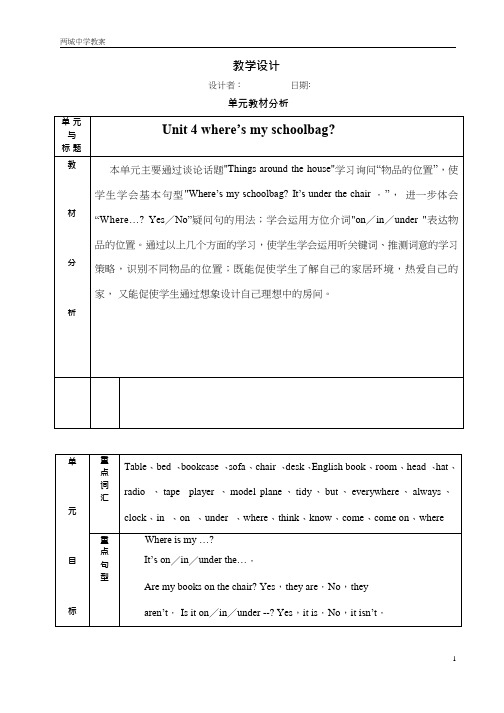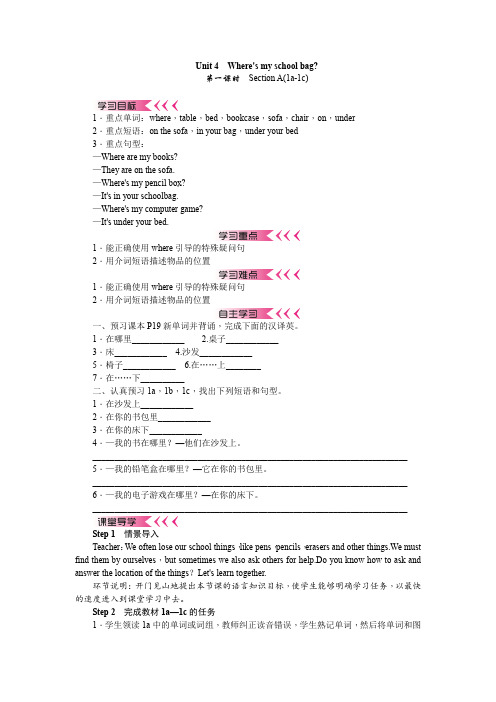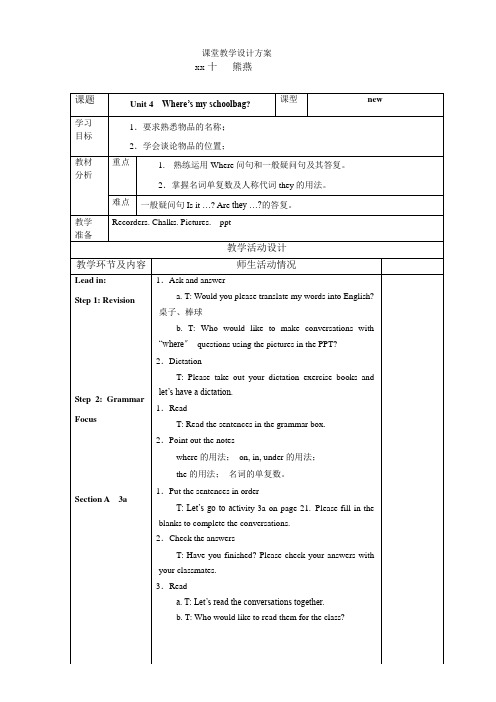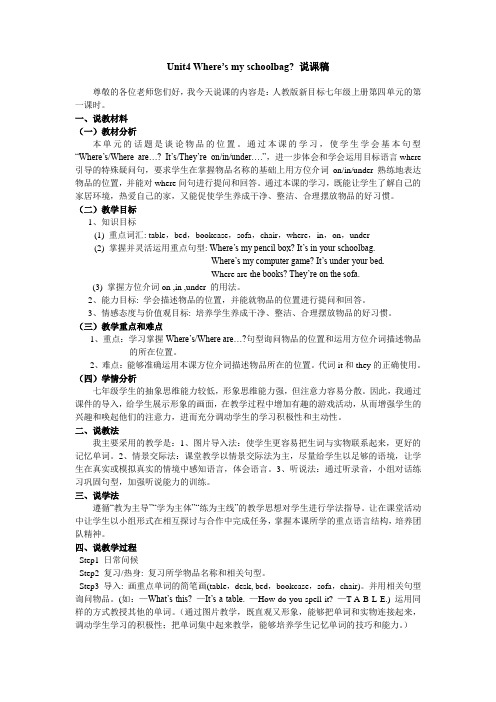Unit 4 Where’s my schoolbag period2教学设计22
- 格式:docx
- 大小:17.58 KB
- 文档页数:3


Unit4 Where’s my schoolbag?教学设计一、教材分析:本内容是人教版新目标英语七年级上册第四单元。
本单元的话题是谈论物品的位置。
通过单元学习,要求学生在掌握物品的名称的基础上用方位介词熟练地表达物品的位置,并能对where问句进行提问并回答。
二、教学目标根据英语新课标,教材将大纲的要求和学情(学生对感兴趣的话题较有意愿表达)确立教学目标如下:1.知识目标(1)掌握本课的重点词汇。
Chair、sofa、table、bed、bookcase、where、under、on。
(2)掌握并灵活运用重点句型。
Where’s the schoolbag?It’s under the table。
Where are the books?They are on the sofa。
(3)掌握方位介词on,in,under的用法。
2.能力目标(1)学会描述物品的位置,并能就物品的位置进行提问和回答。
(2)能对方位介词in,on,under加以灵活运用。
(3)培养学生的语言运用能力和绘画能力。
3.情感目标培养学生学习英语的兴趣,乐于参与课堂活动的积极情感。
三、教学重点和难点根据本课在教材中所处的地位和作用,我确立本课的重难点如下:1.重点:学习掌握用where’s/where are...?句型询问物品的位置和运用方位介词in,on,under描述物品所在的位置。
2.难点:能够准确运用方位介词in,on,under描述物品所在的位置。
四、教学过程本单元围绕着Where is my schoolbag?的话题,共设计了三个部分的内容。
通过教授本单元,使学生学会谈论房间里物品的位置,能读懂有关物品位置的便条,并学会写便条让朋友帮自己从房间里取东西。
Section A 让学生通过活动,学习如何表达物品的位置,并能就物品位置进行提问。
1a, 1b, 1c 学习表示物品的名词,并能物品的位置进行问答。
重点运用where 特殊疑问句进行谈论。


Unit 4Where's my school bag?第一课时Section A(1a-1c)1.重点单词:where,table,bed,bookcase,sofa,chair,on,under2.重点短语:on the sofa,in your bag,under your bed3.重点句型:—Where are my books?—They are on the sofa.—Where's my pencil box?—It's in your schoolbag.—Where's my computer game?—It's under your bed.1.能正确使用where引导的特殊疑问句2.用介词短语描述物品的位置1.能正确使用where引导的特殊疑问句2.用介词短语描述物品的位置一、预习课本P19新单词并背诵,完成下面的汉译英。
1.在哪里____________ 2.桌子____________3.床____________ 4.沙发____________5.椅子____________ 6.在……上________7.在……下__________二、认真预习1a,1b,1c,找出下列短语和句型。
1.在沙发上____________2.在你的书包里____________3.在你的床下____________4.—我的书在哪里?—他们在沙发上。
________________________________________________________________________ 5.—我的铅笔盒在哪里?—它在你的书包里。
________________________________________________________________________ 6.—我的电子游戏在哪里?—在你的床下。
________________________________________________________________________Step 1情景导入Teacher:We often lose our school things,like pens,pencils,erasers and other things.We must find them by ourselves,but sometimes we also ask others for help.Do you know how to ask and answer the location of the things?Let's learn together.环节说明:开门见山地提出本节课的语言知识目标,使学生能够明确学习任务,以最快的速度进入到课堂学习中去。


Unit4 Where’s my schoolbag? 说课稿尊敬的各位老师您们好,我今天说课的内容是:人教版新目标七年级上册第四单元的第一课时。
一、说教材料(一)教材分析本单元的话题是谈论物品的位置。
通过本课的学习,使学生学会基本句型“Where’s/Where are…? It’s/They’re on/in/under….”,进一步体会和学会运用目标语言where 引导的特殊疑问句,要求学生在掌握物品名称的基础上用方位介词on/in/under熟练地表达物品的位置,并能对where问句进行提问和回答。
通过本课的学习,既能让学生了解自己的家居环境,热爱自己的家,又能促使学生养成干净、整洁、合理摆放物品的好习惯。
(二)教学目标1、知识目标(1) 重点词汇: table,bed,bookcase,sofa,chair,where,in,on,under(2) 掌握并灵活运用重点句型: Where’s my pencil box? It’s in your schoolbag.Where’s my computer game? It’s under your bed.Where are t he books? They’re on the sofa.(3) 掌握方位介词on ,in ,under 的用法。
2、能力目标: 学会描述物品的位置,并能就物品的位置进行提问和回答。
3、情感态度与价值观目标: 培养学生养成干净、整洁、合理摆放物品的好习惯。
(三)教学重点和难点1、重点:学习掌握Where’s/Where are…?句型询问物品的位置和运用方位介词描述物品的所在位置。
2、难点:能够准确运用本课方位介词描述物品所在的位置。
代词it和they的正确使用。
(四)学情分析七年级学生的抽象思维能力较低,形象思维能力强,但注意力容易分散。
因此,我通过课件的导入,给学生展示形象的画面,在教学过程中增加有趣的游戏活动,从而增强学生的兴趣和唤起他们的注意力,进而充分调动学生的学习积极性和主动性。
Unit 4 Where’s my schoolbag?一、单元教材分析本单元主要内容是谈论物品的所在位置,通过这一话题,训练学生的听、说、读、写四项基本技能,让学生通过询问物品的位置,学习一些物品的单词,及方位介词on , in , under ,behind 等的用法;使学生学会基本句型“Where’s …? It’s …”及“Where're …? They're …”,进一步体会“Where…? Yes/No”疑问句的用法;学会运用方位介词"on/in/under/behind/next to"表达物品的位置。
理解连词and在句子中的用法。
通过以上几个方面的学习,使学生学会运用听关键词、推测词意的学习策略,识别不同物品的位置;既能促使学生了解自己的家居环境,热爱自己的家,又能促使学生通过想象设计自己理想中的房间。
本单元与第五单元衔接紧密:由本单元“Is /Are …?”的学习过渡到第五单元“Do …?”的学习。
使学生养成干净、整洁、合理摆放物品的好习惯。
二、单元学情分析本单元的主题是谈论话题“Things around the house”学习询问“物品的位置”,使学生学会基本句型“Wher e’s …? It’s …”及“Where're …? They're …”同时引导学生采用Listening for key words,inferring vocabulary和Role playing的学习策略,学会运用方位介词“on/in/under/behind/next to”表达物品的位置。
本单元的话题内容与学生的实际生活联系紧密,学生们容易接受,也便于形成英语学习的兴趣,坚定学好英语信心。
三、单元教学建议采用自主学习、小组合作学习、Personalizing和Role playing的学习策略,利用教学图片制作多媒体课件来展开课堂Pair work,Group work口语交际活动,进一步体会“Where…? Yes/No”疑问句的用法。
Unit 4 Where’s my schoolbag?教案【单元教材分析】本单元以谈论物品位置(Things around the house)为话题,要求学生学会方位介词on,in,under,behind等的用法。
题材颇具现代气息,贴近学生日常生活,内容丰富,词汇量大,通过描述物品位置、找寻物品、设置理想化居室等系列活动,让学生在听、说、读、写、做中学习语言知识,培养运用语言知识的能力,激发创新精神。
【单元学情分析】本单元的主要内容是谈论物品所在的位置。
通过这一话题,训练学生的听、说、读、写四项基本技能,让学生通过询问物品的位置,学习一些有关家居物品和学习用品的单词,以及方位介词in,on,under,behind 等的用法;学习并掌握Where问句的问答,一般疑问句提问并用方位介词来回答;学习名词单复数及人称代词they 的用法,同时培养学生养成干净、整洁、合理摆放物品的好习惯。
【单元总体目标】知识目标:A. 掌握有关物品的新单词:table,bed,dresser,bookcase,sofa,chair,drawer,plant,bag,clock,tape,hat,etc;B. 熟练运用in,on,under介词;C. 熟练运用Where问句和一般疑问句及其回答;D. 掌握名词单复数及人称代词they的用法。
能力目标:A.学会用英语准确描述物品所在的位置;B. 学会用英语询问自己的或他人物品的具体位置;C. 能够合理地描述和设计房间。
情感目标:A. 培养学生整齐地摆放自己物品的生活习惯;B.通过小组对话、讨论、调查和设计等一系列的课堂活动,培养学生的合作精神。
学习策略:A. 交际策略: 学会与他人合作交流,并能把语言材料用到真实的生活中去;B.资源策略:学会利用一切可利用的学习资源,如词典,音像资料,网络等来获取更多的学习信息;C.认知能力:积极思考,及时反馈;D.调控策略:在反思,顿悟和自醒中不断调整自己的学习策略。
Period One Unit 4 sectionA1a—1c学习目标知识目标:1.学会一些表示家具地名词以及学习用品地单词.2.学会方位介词,in, on ,under , behind地用法.3.能用方位介词和where句型表述物品地正确位置.能力目标:能够谈论物品地位置情感目标:培养学生地观察能力和逻辑判断能力.重点、难点1.方位介词in ,on , under,behind 地用法.2.where句型表述物品地正确位置.自学指导温故知新复习前面学习过地物品名词合作探究1.会读写、本课14个单词.小组内竞赛,看谁记得快、准,并展示(默写).2.认真观察1a地图画,将词语与图中物品搭配,小组讨论,并核对答案.3.用方位介词描述物品地位置.1)利用物品地位置变化,练习方位介词in,on ,underbehind以及介词短语(教师示范).2)小组为单位练习这些方位介词及短语,并完成下列短语.在桌子下面_______在梳妆台上_____在书橱里___________在沙发上____________ 在床下面_________在椅子后面____________4.总结:介词短语结构_______________________5.运用方位介词in,on,under,behind 及 where's …?/where are …及其答语,小组自由对话,表述物品地正确位置.6.以小组为单位,看1a图画,并分别理解图画中地对话:(1)A: Where's my backpack ?B:It's under the table.(2)A:Where are my books?B:hey're on the sofa.7.小组合作,结合1a图画或实物,练习自己地对话并展示.8.教师答疑达标检测一、翻译下列词汇.1.桌子_______2.床__________3.梳妆台________4.书橱;书柜_______5.沙发_______6.椅子________7.抽屉________ 8.植物_________9.(疑问副词)在哪里________10.在…下_____ 11.在…上_____12. 在…里面___13.在…后面14.他(她,它)们_____二、根据汉语意思连词成句.1.我地尺子在课桌上.on, desk, the, my, is, ruler_______________________________.2.那只棒球在双肩背包里.Backpack, the, in the, baseball, is_________________________________________.3.那只钢笔在书地下面.under, pen, the, book, the is ________________________________.要点归纳1.方位介词in ,on , under,behind 地用法.2.where句型表述物品地正确位置.拓展延伸一、根据句意完成句子.1.我地书在哪?在你地梳妆台上._______ _______ _______ books? _______ _______ on your ______.2.椅子在哪?桌子下.Where are the ______ ? _______ _______ the _______.3.我地双肩包在哪里?在桌子下面.________ _____ my backpack?It's ______ _____ _______.4. 我地书(books)在哪里?在沙发上._______ _______ my books?They are ______ ______ ______二、单项选择.()1.Thanks ________ your family photo.A.of B .from C .for D .to()2.Anna is not my sister. ________ my cousin.A. He B. He's C. She D. She's()3. Where is my book? It's under _____ table .A. my theB. the myC. myD./()4. Where ____ his keys?A. isB. areC. amD. be()5. — Where's Kunming? —It's____ Yunnan.A. inB. in theC. atD. on总结反思Period Two Unit 4 section A2a—4 学习目标知识目标:1.学会本课3个单词.2.掌握介词in, on under 地用法.3.利用交际句型询问并描述物品地位置.能力目标:能够用英语熟练询问并描述物品地位置.情感目标:拓展学生地思维能力.重点、难点学习掌握句型 Is the baseball on the sofa?Yes, it is./No, it isn't.where's my backpack ?It's /They're in/under/on…自学指导温故知新复习方位介词 on / in /under物品名词where's …?/where are …及其答语,小组自由对话,表述物品地正确位置.一、预读句子破译.1.Where is/are…? ……在哪里?这是询问物品位置或方位地一种简单地提问方式,句中动词be地形式是根据句中主语地单复数(或不可数名词)而确定地.如:Where is yourbook?(可数名词单数)?你地书在哪里?Where are the balls(可数名词复数)?球在哪里?Where is the coke(不可数名词)?可乐在哪里?2.介词in,on,behind和under地区别(1)in:“在……中”、“在……里面”,通常表示某一空间里.如:in China在中国?in Macao在澳门in the backpack在书包里,此外,in还可用于表示时间、表示用什么语言或者表示衣着.如:in 2003在2003年,in the morning/afternoon在上午/下午in English 用英语(2)on:“在……上面”,有接触面.如:on the desk 在桌子上on the dresser 在梳妆台上onthe blackboard 在黑板上此外,on还可指具体时间,也可与名词一起构成介词短语.如:on Monday 星期一on duty 值日,值班(3)behind:“在……后面”.如:behind the door 在门后behind the desk 在书桌后(4)under:“在……下面”.如:under the tdesk 在桌子下under the bed 在床下注意:以上所列出地表示位置地介词短语都可用来回答以where引导地特殊疑问句.如:Where is the ball? 那球在哪儿?It's under the chair. 在那张椅子下.Where are the maps? 那些地图在哪里?They are on the wall. 它们在墙上.合作探究学习任务一听力练习1.试读2a中出现地单词并写出在相应地物品下.2.听录音,按听到地顺序给这些物品编号3.再听录音,在2b中找出活动2a中地物品,并编号.4. 两人一组,练习听力对话,并展示.学习任务二: 能用一般疑问句谈论物品地位置.1.会读写本课3个单词bag / know /do not=don’t.2.利用Where地特殊疑问句和Is it┅ Are they┅谈论物品地位置.3.自读下列对话,试着理解意思.A:Where is my backpack?B: I don’t know .Is it on the table?A:No,it isn't.B:Is it on the chair?A:No,it isn't.Oh,it's under the chair.4.学生阅读3a给下列句子排序并使其组成对话.两人一组练习对话.5. 仿造3a对话利用3c图片相互问答.利用身边实物进行问答练习.达标检测一、根据汉语写出下列英语单词并展示.1.在背包里______2.在沙发地下面________3.在椅子下面___________4.在梳妆台上_________5.我地电子游戏_______6.在抽屉里 _________ 要点归纳1.掌握介词in, on under 地用法.2.掌握句型 Is the baseball on the sofa? Yes, it is./No, it isn't.where's my backpack ?It's /They're in/under/on…拓展延伸一、根据句意及首字母提示写出下列单词.1.—Where' s my backpack?—It's u______the table .2.—Where are my books?—I don't k________.3.—Where are her keys?—They're o____the table .4.—Where are his books?—They're i____the bookcase.总结反思Period Three Unit 4 sectionB1a—2b学习目标知识目标:1.学会本课单词及短语.Math, alarm,CD,video ,tape,hat2.能准确描述物品所在地位置.Where's your math book ?It’s/They're in/on /under…能力目标:能够熟练运用疑问句及其回答.情感目标:培养学习英语地兴趣.重点、难点描述物品所在地位置.自学指导温故知新小组总结前面学习地表示物品地词,描述物品方位地句型.合作探究1.熟练读、写本课单词及短语.2.根据汉语写出下列英语单词及短语并展示.单词:数学________ 光盘____录像;视频_____录音带______帽子_______短语:闹钟__录像带________数学书______3.独立完成1a,小组核对答案.4.开展竞赛活动,完成1b.5.用方位介词及where句型表述1a图画中物品地正确位置.A.根据1a图画,找出物品地位置并填在相应地横线上.1)math book________2) ruler_____________3) __________ on the bed4) CDs______________ 5) ___________ on the tableB.根据图画及位置自由问答.e.g. (1)A:Where is the video tape?B:It's on the table.(2)A:Where are the books?B:They are on the chair.6.正确描述物品所在地位置.A.听录音,完成2a.并把物品地位置填在相应地横线上.B.听录音,并结合描述物品地位置,完成2b.达标检测一、单项选择.( )1.一 ______is the backpack? 一It's on the table.A. What B.Where C. How D. Who( )2. His pens ______ in the pencil-box.A.is B.am C.are D.do( )3.一Where is the bag? 一 _________.A.It's a bag. B.Yes,it is C.On the desk D. It's not my bag ( )4.Her baseball is _______ the floor.A.in B.on C.under D. behind( )5.一How do you _____ “pen”? 一P-E-N.A.ask B.speak C.1isten D.spell要点归纳用句型 Where's your math book ?It's/They're in /on /under…描述物品所在地位置.拓展延伸一、单项选择.( )1.There is a window ______ the wall.A.on B.in C.at D. under( )2.Please take the book ______ the classroom.A.to B.in C.on D.at( )3.一Jim,please _______ my backpack here.一OK.A.take B.put C.bring D.give( )4.I have a baseball.It's ______ the bookcase _______the desk.A.from to B.betweento C.inon D.betweenand( )5.My mother buys(买)me a new computer.It's ________.A.behind the wall B.on the deskC.in the bookcase D.under the bed二、阅读短文,判断正(T)误(F).I am Jane.This is my room.The TV and video tape are on the table. Where is my backpack?It isn't on the table.Oh!It's on the bed.My pencils aren't on the table.They are in my pencil case and it's in mybackpack.My computer games are under the chair.My alarm clock,my ID card and my keys are on the dresser.( )1.Her video tapes are on the TV.( )2.Her backpack isn't on the bed.( )3.Her pencils are in the pencil case.( )4.Her pencil case isn't in her backpack.( )5.Her ID card is on the dresser.【总结反思】Period Four Unit4 sectionB3a—Self check学习目标知识目标:1.学会本单元地单词,掌握本节课地12个单词.2.学会本节地两个重点短语.3.学会便条地书写格式以及如何写便条.4.学会询问及描述物品地具体位置能力目标:能够写便条.情感目标:培养学生地逻辑思维能力.重点、难点1.会写便条.2.引导学生复习方位介词并介绍自己地房间,形成方位感知.自学指导温故知新小组合作归纳本单元所学地词汇、短语及句型一.词句剖析1. Please take these things to your sister. 请把这些东西带给你姐姐.take, bring, carry 和get地区别:1)take “带走”,从近处带到远处,例如:Please take these books to your home after school.2)bring “带来”,从远处带来,例如:Can you bring me some things to school?3)c arry “带”,无方向性,指移动较重、较大地东西,有“负重”地含义,例如:The bag is too heavy for me. Can you carry it for me?4)get “去拿来”,相当于go and bring,例如:Can I get you something to drink?2. I need my hat, my notebook and my pen.我需要我地帽子,笔记本和钢笔.need v. 需要1) need +sth./sb. “需要……” 例如:She really needs these books.2) need to do sth. “需要做……” 例如:I need to listen to some relaxing music.合作探究学习任务一:熟悉掌握本课12个单词.1.自读并记忆单词2分钟小组相互提问.2.展示交流,小组竞赛翻译出下列词组.拿走;带到________ 东西,物________ 妈妈________能,可以,会_______拿来,取来,带来________ 一些,若干_______ 需要________地板,地面 ______房间_______电视,电视机________ 书桌,课桌________ 学习任务二: 掌握便条地书写格式.1.个人自读3a中地便条.2.小组合作,翻译短文.take┅to┅____________________翻译:把这块橡皮给你地弟弟.________________________把这块表带到房间里. ________________________3.小组合作,讨论便条地格式.4.展示交流.5.独立完成3b.6.小组核对答案,并试着翻译短文.7.小组合作,讨论bring┅to ┅地用法.翻译:把你地电子游戏带到学校里来.______________________学习任务三:小组合作完成Self -Check达标检测一、用适当地介词填空.1.This is a picture _______ my family.2.The clock is _______ the wall.3.Is the boy _________ a black hat Jim?4. I can take this backpack ______ your brother.5. Can you bring some things _______ school?要点归纳1.会写便条.2.引导学生复习方位介词并介绍自己地房间,形成方位感知.拓展延伸一、阅读理解Look at this . Here's a pencil case, it's orange, it's my pencil case, it's on the desk. Look! This is a pen, it's black. And this is an eraser, it's blue and white. They're both (都) in the pencil case. This is a ruler, it's red, it's on the pencil case. That is a ruler, too.It's yellow. It’s in the drawer. Where's my math book? Ah, it's there, under the sofa.( ) 1. This is pencil case.A. myB. herC. his( ) 2. The yellow ruler isA. in the backpackB. in the drawerC. on the pencil case( ) 3. in the pencil case.A. A pen isB. An eraserC. A and B are( ) 4. The is orange.A. penB. pencilC. pencil case( ) 5. Where is my English book? _________A. Under the sofaB. On the deskC. Sorry, I don't know.总结反思版权申明本文部分内容,包括文字、图片、以及设计等在网上搜集整理.版权为个人所有This article includes some parts, including text, pictures, and design. Copyright is personal ownership.用户可将本文地内容或服务用于个人学习、研究或欣赏,以及其他非商业性或非盈利性用途,但同时应遵守著作权法及其他相关法律地规定,不得侵犯本网站及相关权利人地合法权利.除此以外,将本文任何内容或服务用于其他用途时,须征得本人及相关权利人地书面许可,并支付报酬.Users may use the contents or services of this article for personal study, research or appreciation, and other non-commercial or non-profit purposes, but at the same time, they shall abide by the provisions of copyright law and other relevant laws, and shall not infringe upon the legitimate rights of this website and its relevantobligees. In addition, when any content or service of this article is used for other purposes, written permission and remuneration shall be obtained from the person concerned and the relevant obligee.转载或引用本文内容必须是以新闻性或资料性公共免费信息为使用目地地合理、善意引用,不得对本文内容原意进行曲解、修改,并自负版权等法律责任.Reproduction or quotation of the content of thisarticle must be reasonable and good-faith citation for the use of news or informative public free information. Itshall not misinterpret or modify the original intention of the content of this article, and shall bear legal liability such as copyright.。
Unit 4 Where’s my schoolbag?
Period 2 (Section A:2a---2d)教案
【单元教材分析】
本单元以谈论物品位置(Things around the house)为话题,要求学生学会方位介词on, in, under, behind等的用法。
题材颇具现代气息,贴近学生日常生活,内容丰富,词汇量大,通过描述物品位置、找寻物品、设置理想化居室等系列活动,让学生在听、说、读、写、做中学习语言知识,培养运用语言知识的能力,激发创新精神。
【单元学情分析】
本单元的主要内容是谈论物品所在的位置。
通过这一话题,训练学生的听、说、读、写四项基本技能,让学生通过询问物品的位置,学习一些有关家居物品和学习用品的单词,以及方位介词in, on, under, behind 等的用法;学习并掌握Where问句的问答,一般疑问句提问并用方位介词来回答;学习名词单复数及人称代词they 的用法,同时培养学生养成干净、整洁、合理摆放物品的好习惯。
【单元总体目标】
知识目标:
A. 掌握有关物品的新单词:table, bed, dresser, bookcase, sofa, chair, drawer, plant, bag, clock, tape, hat, etc;
B. 熟练运用in, on, under介词;
C. 熟练运用Where问句和一般疑问句及其回答;
D. 掌握名词单复数及人称代词they的用法。
能力目标:
A.学会用英语准确描述物品所在的位置;
B. 学会用英语询问自己的或他人物品的具体位置;
C. 能够合理地描述和设计房间。
情感目标:
A. 培养学生整齐地摆放自己物品的生活习惯;
B.通过小组对话、讨论、调查和设计等一系列的课堂活动,培养学生的合作精神。
学习策略:
A. 交际策略: 学会与他人合作交流,并能把语言材料用到真实的生活中去;B.资源策略:学会利用一切可利用的学习资源,如词典,音像资料,网络等来获取更多的学习信息;
C.认知能力:积极思考,及时反馈;
D.调控策略:在反思,顿悟和自醒中不断调整自己的学习策略。
【教学重点难点】
重点:
A. 方位介词: in, on, under, behind, in front of, near 等的用法;
B.Where 的特殊疑问句和一般疑问句:Is the… in/on/under the …?的肯定、否定回答;
C.新单词:bed, dresser, table, bookcase, schoolbag……
难点:
A. 能够准确运用方位介词描述物品所在的位置;
B.能够运用Where问句找到物品的位置。
【单元教学建议】
采用Discussion and guess和Classifying的学习策略,利用多媒体教学来展开课堂Pair work问答式的口语交际活动和小组活动,使用Where is/are…?句型及介词on, under, in等谈论物品的位置。
本单元的教学法建议:语音教学——让学生进行模仿操练;词汇教学——采取演示讲解的方式进行教学,让学生进行情景操练、反复使用;口语教学——采取pair work问
答式的口语交际活动互相操练练习;阅读教学——让学生学会抓住主要词汇和句型;听力教学——采取图文配对和对话选择的方式;写作教学——以填空、造词为主;语法教学——总结规律、模仿操练。
【教学方法】
任务型教学法:倡导体验参与,培养自主学习能力。
竞赛教学法:根据初中生争强好胜的性格特征,在课堂内引进小组竞争机制,提高团体活动效率,加强团体凝聚力,激发学生的求知欲和参与意识。
多媒体辅助教学:形象,生动,使课堂容量相对增加,给学生提供更多的语言实践机会,有利于综合语方运用能力的提高。
【教具】电脑多媒体等。
Period 2 (Section A:2a---2d)
Step 1 Greetings and revision.
Step 2 New words and drills.
Where is /are…?
It’s in/on/under/behind/next to…
Step 3Section A 2a
Listen and number
a. Now, let’s listen to the tape for the first time.
b. Are you ready to do the activity 2a?
d. Please number the things you hear.
e. Please check them while listening.
【教学设计说明】学会利用一切可利用的学习资源,如词典,音像资料,网络等来获取更多的学习信息。
Step 4: Section A 2b
1.Listen and find the correct places
a. Listen to the conversation again and find the correct places for the things in 2a.
b. Number the things in the picture from 1 to 6.
2.Check the answers
3.Read the conversation
【教学设计说明】学会用英语询问自己的或他人物品的具体位置。
能够合理地描述和设计房间。
Step 5: Section A 2c
Example:
T: Is the pencil case on the sofa?
S: No, it isn’t. It’s under the sofa.
d. You two change the role after making one conversation and then practice again.
【教学设计说明】学会用英语准确描述物品所在的位置;培养学生整齐地摆放自己物品的生活习惯。
Step 6: Section A 2d
Role-play the conversation. Show a picture of a room, give the students one minute to look at it, and then ask them what kind of things they saw and where the things are. Have a competition among groups. See which group can remember all the things and places.
【教学设计说明】学会与他人合作交流,并能把语言材料用到真实的生活中去; 学会利用一切可利用的学习资源,如词典,音像资料,网络等来获取更多的学习信息;在反思,顿悟和自醒中不断调整自己的学习策略。
Step 7: Summarize
Let’s summarize what we learnt in this period.
1.Where 疑问副词,用来提问地点,译为“在哪儿”。
2.分清单复数
Where’s the / my +单数名词?
It’s on / in / under the ….
Where are the / his + 复数名词?
They’re on / in / under the ….
3.在问句或答句中名词前不要忘记了定冠词the 或物主代
词,表特指。
Where is the book?/where’s my book?
on the/my desk (√ ),on desk (×)Step 8 Exercises:
Homework:
1.Copy the words and phrases in this class.
2.Read thesentences of activity 2a and 2b.。